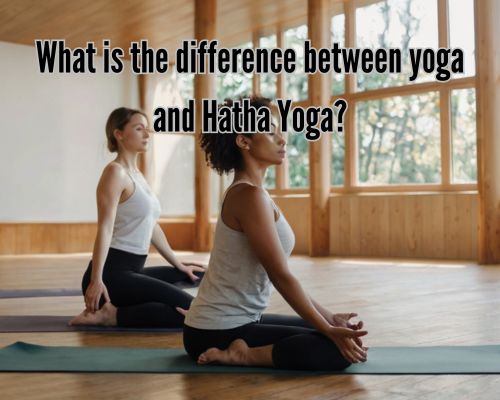
Yoga is a practice that has transcended borders and cultures, evolving into one of the most popular wellness activities worldwide, including in Australia. Among its many branches, Hatha Yoga often emerges as a specific term that creates curiosity and, sometimes, confusion. To many Australians who practice yoga in studios from Sydney to Perth or at home, understanding the distinction between yoga as a general concept and Hatha Yoga can provide clarity and elevate their practice.
In this article, we’ll delve into the nuanced differences between yoga and Hatha Yoga, explore their origins, and discuss their relevance in Australia’s growing yoga community.

Understanding Yoga: A Broad Spectrum
Yoga is an ancient practice originating in India, with its roots dating back thousands of years. It encompasses a comprehensive approach to life, integrating physical, mental, and spiritual elements. At its core, yoga aims to achieve a state of union between mind, body, and spirit, which is reflected in its Sanskrit meaning: “union.”
Yoga is more than just physical postures; it includes breathing techniques (pranayama), meditation, and ethical principles. Over time, yoga has diversified into numerous styles, such as Vinyasa, Ashtanga, Kundalini, Bikram, and, of course, Hatha Yoga. Each style focuses on unique aspects of the practice, tailored to different needs and preferences, see https://bikramyogamornington.com.au/.
Hatha Yoga: The Foundation of Physical Yoga
Hatha Yoga is often considered the foundation of modern yoga. The word “Hatha” derives from two Sanskrit words: “Ha” (sun) and “Tha” (moon), symbolizing balance. In essence, Hatha Yoga focuses on balancing opposites within the body and mind through physical postures (asanas), breath control (pranayama), and mindfulness.
In traditional terms, Hatha Yoga serves as a preparatory step toward achieving higher states of meditation. Its slower, deliberate pace allows practitioners to focus on alignment and develop strength, flexibility, and balance.
Many yoga classes in Australia, particularly beginner classes, are Hatha-focused because of their approachable and gentle nature. Studios in cities like Melbourne, Brisbane, and Adelaide often use Hatha Yoga to introduce students to yoga principles, building a solid foundation for more dynamic styles.
Key Differences Between Yoga and Hatha Yoga
While Hatha Yoga is a subset of yoga, their differences lie in their scope, focus, and application. Below are some key distinctions:
1. Scope
- Yoga: Refers to the broader philosophy and practices aimed at achieving spiritual growth and self-realization. It includes eight limbs, as outlined in the Yoga Sutras of Patanjali, such as ethical principles (Yamas and Niyamas), concentration (Dharana), and meditation (Dhyana).
- Hatha Yoga: Primarily focuses on the physical aspect of yoga, including postures (asanas) and breathwork, making it more accessible to those beginning their yoga journey.
2. Intensity
- Yoga: Depending on the style, it can range from physically intense (e.g., Ashtanga or Power Yoga) to meditative and restorative (e.g., Yin Yoga).
- Hatha Yoga: Typically slower and less intense, emphasizing mindfulness and proper alignment over dynamic movement.
3. Goals
- Yoga: Encourages a holistic transformation, integrating physical, emotional, and spiritual well-being.
- Hatha Yoga: Focuses on improving physical strength, flexibility, and relaxation as a foundation for deeper yoga practices.
See https://bikramyogamornington.com.au/ for more.
The Popularity of Yoga and Hatha Yoga in Australia
Australia’s yoga community has embraced various styles, making yoga a vital part of the nation’s wellness culture. According to the Australian Yoga Journal, the practice is growing, with over two million Australians engaging in yoga regularly. Hatha Yoga remains a favorite, particularly among beginners, due to its slower pace and adaptability.
Cities like Sydney and Melbourne are home to numerous yoga studios offering Hatha Yoga classes, such as Power Living and Humming Puppy. Additionally, yoga retreats in serene locations like Byron Bay often incorporate Hatha Yoga as part of their programs, blending physical practice with relaxation and mindfulness.
Benefits of Hatha Yoga in the Australian Context
Practicing Hatha Yoga offers numerous benefits, making it an excellent choice for Australians of all fitness levels and ages. Below are some benefits particularly relevant to Australia’s active and health-conscious population:
1. Stress Relief in Urban Settings
Hatha Yoga’s calming approach is ideal for Australians living in bustling cities like Sydney or Melbourne. With its focus on breath and mindfulness, it offers an escape from the daily grind, helping practitioners reduce stress and improve mental clarity.
2. Physical Fitness and Flexibility
Hatha Yoga provides a gentle yet effective way to enhance physical fitness, which resonates well with Australia’s fitness culture. Its emphasis on slow, controlled movements makes it accessible to individuals of varying fitness levels.
3. Enhancing Outdoor Experiences
Australia’s outdoor lifestyle pairs well with yoga. Practicing Hatha Yoga in parks, beaches, or retreats allows individuals to connect with nature, aligning with yoga’s holistic philosophy. Byron Bay, for example, is renowned for its outdoor yoga classes and retreats.
4. Community and Inclusion
Hatha Yoga fosters a sense of community, whether in studio classes or yoga retreats. This sense of belonging is particularly appealing to Australians, who value social connections and inclusive activities.
How to Start Practicing Hatha Yoga in Australia
If you’re curious about exploring Hatha Yoga, Australia offers a wealth of opportunities. Here’s how to get started:
1. Find a Local Studio
Studios like YogaBar (with locations across Sydney) or My Health Yoga in Queensland offer beginner-friendly Hatha Yoga classes.
2. Explore Online Options
With platforms like Yoga Australia and online classes through providers like Gaia, you can practice Hatha Yoga from the comfort of your home.
3. Join a Retreat
Consider attending a yoga retreat in popular destinations like Byron Bay or the Sunshine Coast, where you can deepen your Hatha Yoga practice in a serene environment.
4. Start Small at Home
You don’t need fancy equipment to start Hatha Yoga. A yoga mat, comfortable clothing, and guided videos are enough to begin.
Conclusion: Yoga and Hatha Yoga in Harmony
In summary, the difference between yoga and Hatha Yoga lies in their scope and focus. While yoga represents a holistic philosophy encompassing mental, physical, and spiritual well-being, Hatha Yoga hones in on the physical and preparatory aspects. Its approachable nature makes it a cornerstone for yoga beginners across Australia.
Whether you’re attending a class in Brisbane, practicing on a beach in Perth, or exploring yoga retreats in Byron Bay, understanding the nuances of Hatha Yoga can enhance your journey. With Australia’s growing yoga community, now is the perfect time to embrace the practice and discover its transformative benefits.
By incorporating elements of mindfulness, balance, and fitness, Hatha Yoga seamlessly aligns with Australia’s wellness-focused lifestyle. So, why not roll out your mat and give it a try? Whether you’re a novice or a seasoned yogi, Hatha Yoga offers something for everyone.
Let your yoga journey begin today!


